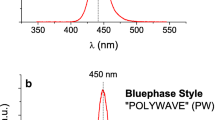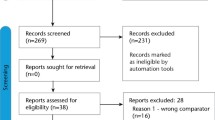Abstract
The aim of this study was to evaluate the influence of the physical assessment of different light-curing units from 55 dental offices on the irradiance and composite microhardness top/bottom ratio, and the influence of the radiometers for LED or QTH light sources on irradiance measurement. The irradiance of each light-curing unit was evaluated with two radiometers, either for LED or QTH light. A questionnaire regarding the type of source (LED or QTH), time of use, date of last maintenance and light-curing performance assessment applied. The physical assessments were evaluated regarding damage or debris on the light tip. For each light-curing unit, three composite specimens were made (diameter = 7 mm; thickness = 2 mm) with polymerizing time of 20 s, in order to perform the microhardness (Knoop) test. Data were analyzed by Kruskal–Wallis and Dunn test (α = 0.01). There was wide variation in irradiance (0–1000 mW/cm2). Approximately 50 % of the light-curing units presented radiation lower than 300 mW/cm2; 10 % of light-curing units, especially those with LED source, presented values higher than 800 mW/cm2, and 43 % of light-curing units worked with adequate irradiance between 301 and 800 mW/cm2. In almost 60 % of cases, no maintenance of light-curing units was performed in a period of 3 to 10 years. The age of the light-curing units and the use of inadequate tips interfered negatively in irradiance. The data emphasize the importance of periodic maintenance of light-polymerizing, light-curing units.



Similar content being viewed by others
References
Price RB, Labrie D, Kazmi S, Fahey J, Felix CM. Intra- and inter-brand accuracy of four dental radiometers. Clin Oral Investig. 2012;16(3):707–17.
El-Mowafy O, El-Badrawy W, Lewis DW, Shokati B, Kermalli J, Soliman O, Encioiu A, Zawi R, Rajwani F. Intensity of quartz-tungsten-halogen light-curing units used in private practice in Toronto. J Am Dent Assoc. 2005;136(6):766–73 (quiz 806-7. 2).
Hao X, Luo M, Wu J, Zhu S. A survey of power density of light-curing units used in private dental offices in Changchun City, China. Lasers Med Sci. 2013 May 23. (Epub ahead of print).
Pilo R, Oelgiesser D, Cardash HS. A survey of output intensity and potential for depth of cure among light-curing units in clinical use. J Dent. 1999;27(3):235–41.
Barghi N, Fischer DE, Pham T. Revisiting the intensity output of curing lights in private dental offices. Compend Contin Educ Dent. 2007;28(7):380–4 (quiz 385-6.).
Maghaireh GA, Alzraikat H, Taha NA. Assessing the irradiance delivered from light-curing units in private dental offices in Jordan. J Am Dent Assoc. 2013;144(8):922–7.
Calheiros FC, Kawano Y, Stansbury JW, Braga RR. Influence of radiant exposure on contraction stress, degree of conversion and mechanical properties of resin composites. Dent Mater. 2006;22(9):799–803.
Hegde V, Jadhav S, Aher GB. A clinical survey of the output intensity of 200 light curing units in dental offices across Maharashtra. J Conserv Dent. 2009;12(3):105–8.
Rueggeberg FA, Caughman WF, Curtis JW Jr. Effect of light intensity and exposure duration on cure of resin composite. Oper Dent. 1994;19(1):26–32.
ANSI/ADA Specification No. 48 Visible Light Curing Units (2004, R2009).
ANSI/ADA Specification No. 48-2 LED Curing Lights (2010).
Roberts HW, Vandewalle KS, Berzins DW, Charlton DG. Accuracy of LED and halogen radiometers using different light sources. J Esthet Restor Dent. 2006;18(4):214–22 (discussion 223-4).
Leonard DL, Charlton DG, Hilton TJ. Effect of curing-tip diameter on the accuracy of dental radiometers. Oper Dent. 1999;24(1):31–7.
Tango RN, Sinhoreti MA, Correr AB, Correr-Sobrinho L, Henriques GE. Effect of light-curing method and cement activation mode on resin cement knoop hardness. J Prosthodont. 2007;16(6):480–4.
Martin FE. A survey of the efficiency of visible light curing units. J Dent. 1998;26(3):239–43.
Miyazaki M, Hattori T, Ichiishi Y, Kondo M, Onose H, Moore BK. Evaluation of curing units used in private dental offices. Oper Dent. 1998;23(2):50–4.
Santos GC Jr, Santos MJ, El-Mowafy O, El-Badrawy W. Intensity of quartz-tungsten-halogen light polymerization units used in dental offices in Brazil. Int J Prosthodont. 2005;18(5):434–5.
David JR, Gomes OM, Gomes JC, Loguercio AD, Reis A. Effect of exposure time on curing efficiency of polymerizing units equipped with light-emitting diodes. J Oral Sci. 2007;49(1):19–24.
McAndrew R, Lynch CD, Pavli M, Bannon A, Milward P. The effect of disposable infection control barriers and physical damage on the power output of lightcuring units and light curing tips. Br Dent J. 2011;210(8):E12.
Meyer GR, Ernst CP, Willershausen B. Decrease in power output of new light-emitting diode (LED) curing devices with increasing distance to filling surface. J Adhes Dent. 2002;4(3):197–204.
Warren DP, Rice HC, Powers JM. Intensity of curing lights affected by barriers. J Dent Hyg. 2000;74(1):20–3.
Price RB, Labrie D, Kazmi S, Fahey J, Felix CM. Intra-and inter-brand accuracy of four dental radiometers. Clin Oral Investig. 2012;16(3):707–17.
Author information
Authors and Affiliations
Corresponding author
Ethics declarations
Conflict of interest
The authors declare that they have no conflict of interest.
Rights and permissions
About this article
Cite this article
Morimoto, S., Zanini, R.A.M., Meira, J.B.C. et al. Influence of physical assessment of different light-curing units on irradiance and composite microhardness top/bottom ratio. Odontology 104, 298–304 (2016). https://doi.org/10.1007/s10266-015-0229-y
Received:
Accepted:
Published:
Issue Date:
DOI: https://doi.org/10.1007/s10266-015-0229-y




